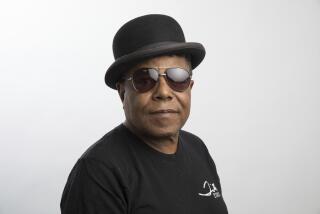On a Musical Mission : Branford and Ellis Marsalis Lead Jazz Clinic at CSUN for ‘the Next Generation’
In the Music Recital Hall at Cal State Northridge, stagehands were trying mightily to perfect the lights, the sound--anything to please saxophonist Branford Marsalis and his father, pianist Ellis Marsalis.
But the two members of the Marsalis clan--often called the “First Family of Jazz”--couldn’t have been more relaxed Wednesday afternoon, or less interested in technical perfection than in simply talking to students about jazz.
“You know you’re in L.A.,” Branford Marsalis quipped. “Everything has to be such a production.”
The jazz clinic, as it was billed, was a treat for the 180 students, primarily music majors. Though the Marsalises are in town promoting a new CD, they don’t have any concerts scheduled here. The master class was one of several university pit stops they have made while touring to support “Loved Ones,” a collection of romantic ballads.
“That’s what we’re supposed to do,” said Branford of their educational mission. “Assist the next generation in developing. Like my father always told me: ‘If you’re not any better than me, then I’ve failed as a teacher.’ ”
Playing with his father while growing up spoiled him for other pianists, Branford said, because his father is so magnanimous in talent and spirit.
Their house in New Orleans was full of music. In addition to Branford and Ellis, there were younger brothers Wynton, the trumpeter; Delfeayo, a trombonist and record producer, and up-and-coming drummer Jason, now 19. Ellis credits his wife with nurturing the talent in the house. The one original song on the album, “Dear Dolores,” is dedicated to her.
Much of the discussion at CSUN centered on the music business and the marketing of jazz artists. To 35-year-old Branford, the attention given to young musicians hasn’t always been a blessing. Record companies put too much emphasis on snazzy suits and not enough on skill, he said.
“I think it’s safe to say that today Stevie Wonder couldn’t even get a record deal,” said Branford, who was dressed in plaid shorts, a T-shirt and baseball cap. When companies market to the MTV generation, he said, “imagery is everything and the musicianship is optional.”
When the talk turned to music education, Ellis, who now teaches at the University of New Orleans, stressed the value of spending time studying music. At 40, with five children at home, he went back to college. He stopped hustling piano gigs where, he said, “If you were lucky, you were two weeks from unemployment.” He wound up teaching at a performing arts magnet school in New Orleans.
It wasn’t easy. Just because you can play, Ellis said, doesn’t mean you can teach someone else to.
“That was the thing he drilled into me,” Branford said. “You don’t go [to college] to get an education, you go to learn. . . . If you don’t have the impetus to learn, it doesn’t matter where you go--you’re screwed.”
When messages like that come from someone like Branford or Ellis Marsalis, they will linger in students’ minds, said music professor Joel Leach, who heads CSUN’s jazz program. That’s why he jumped at the chance to host the clinic. The Marsalises’ appearance also gave students inspiration, he said, and a requisite amount of hero-worship.
“I just think it’s a privilege for us at CSUN to have such high-caliber musicians here,” said senior Brian Rupp, a classical guitarist. “I think they gave us a realistic view of the music industry.”
*
After an hour of questions, someone asked: Would you play a little for us? The room fell silent as Ellis glided his fingers over the keys of the grand piano and started to draw out the chords of George Gershwin’s “Bess You Is My Woman Now.” The audience was full of concentrated--and envious--faces.
Then, even after Leach said they had to leave, the Marsalises started into “Maria,” from Leonard Bernstein’s “West Side Story.” The way they worked their way into, through, and around those three notes--”Ma-ri-a”--was as concrete a jazz lesson as anything spoken in the hour before.
They laid melodies down over each other’s accompaniment, blending like two jazz musicians who have played together their whole lives. Like father and son.
More to Read
The biggest entertainment stories
Get our big stories about Hollywood, film, television, music, arts, culture and more right in your inbox as soon as they publish.
You may occasionally receive promotional content from the Los Angeles Times.










